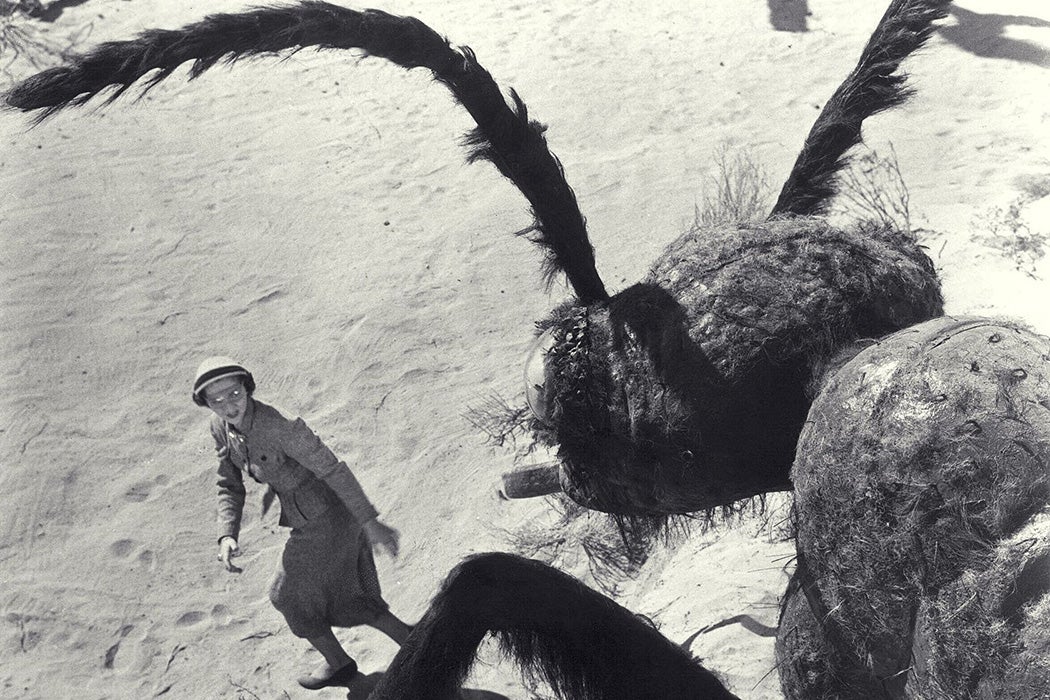What if the “big bug movies” of the 1950s, long seen as fever dreams of the Cold War, are really all about the fear of actual insects and arachnids? Just plain old swarming bugs, like the defoliating gypsy moths that plagued the Northeast and the imported fire ants that tormented the South during this period?
Scholar William M. Tsutsui argues that these movies should actually be taken literally, not as symbolic manifestations of “nuclear fear, concern over communist infiltration, ambivalence about science and technocratic authority, [or] repressed Freudian impulses.” Tsutsui continues: “Movies like Them! and Earth vs. the Spider reflected a widespread unease about insect infestation and humankind’s ability to control it during the 1950s and 1960s, the pre-Silent Spring heyday of DDT and sweeping government pest control offensives.” In films like these and Tarantula (1955), The Black Scorpion (1957), Beginning of the End (1957), and The Monster from Green Hell (1957), the era’s “war on insects” comes to life on the big screen.
The best of the big bug movies is probably Them!, Warner Brothers’ highest-grossing film of 1954. In it, giant ants resulting from atomic testing in the Southwest take to the sewers of Los Angeles. The movie’s commercial success—and its relatively respectful reception by critics—spawned a scurry of movies starring oversized locusts, spiders, wasps, and other chitinous monsters on the rampage. In 1957’s The Deadly Mantis, for instance, the eponymous creature attempts to take Manhattan via the Holland Tunnel, like a regular commuter.
The Naked Jungle (1954) may be the purest expression of the era’s insect panic, which built on the prewar memories of locusts in the West and cotton boll weevils in the South. After World War II, humankind was supposed to be at war against crop-devouring and disease-spreading insects. Science fiction was full of tales of social insects inheriting the Earth, while real agronomists, entomologists, and the chemical companies that often employed such scientists were not far behind in their warnings of the coming insect victory.
“Real-world fears of real-world pests flowed seamlessly into cinematic fears of fantastical giant ants and locusts,” writes Tsutsui. Noting that the hyperbolic dialogue in such films could very well have come from actual entomologists warning of the dangers of actual insects, Tsutsui writes that DDT was sold as the “salvation of humankind, the ‘killer of killers,’ and the ‘atomic bomb of insecticides.’”
Weekly Newsletter
But DDT wasn’t the wonder drug it was sold as. Its effectiveness wore off as insects adapted to it, and its side effects were a disaster for non-insect species. In the big bug movies, insecticides pointedly don’t work: Tsutsui gives examples of DDT specifically being cited as worthless against the giant bugs. The fear of bugs metamorphosed into anxieties over the efficacy and unintended effects of bug-killing efforts. In fact, Tsutsui points to the probably-not-coincidental simultaneous demise of the genre and the publication of Rachel Carson’s Silent Spring (1962).
“By the early 1960s,” Tsutsui concludes, “it had become clear that the potential of chemical insecticides like DDT and the threat of insect hoards overrunning humanity had both been exaggerated. Insects were not poised to ‘inherit the earth’ and, when it came to pest control, the solutions could be more dangerous than the problems themselves.”
The era of the big bug terror was squashed.







